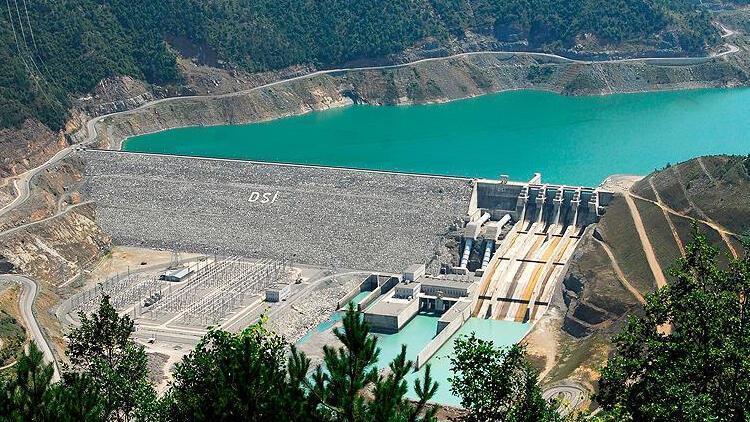
Although Turkey's installed hydropower capacity is continuing its growth, output from hydropower plants has fallen to 20.1 percent in electricity generation during the January-July period of this year, according to data compiled by Anadolu Agency on Sept. 1.
By the end of July, 735 hydropower plants generated electricity in Turkey.
The share of these plants in the country's total electricity generation of 188.7 billion kilowatt-hours was 20.1 percent, or 37.9 billion kilowatt-hours during the January-July period of this year.
Hydropower plants saw a dramatic drop in output due to drought, which first emerged in the last quarter of 2020.
The share of hydropower plants in electricity generation during the January-July period of 2020 hit 31.6 percent, generating 53.8 billion kilowatt-hours of electricity out of the total of 170.4 billion kilowatt-hours.
At the end of July this year, Turkey's hydropower capacity reached 31,436 megawatts, accounting for 32 percent of the country's total installed power capacity of 98,264 megawatts.
Hydropower constituted 60 percent of Turkey's total installed renewable capacity, which stood at 52,000 megawatts.
The country’s first hydropower plant, the Tarsus plant in the Mersin province, began operations in 1902 with a capacity of 60 kilowatts. This increased to 18 megawatts in 1950, and up to 412 megawatts in 1960.
Turkey's hydropower capacity accelerated especially after the year 2000 to 13,063 megawatts by the end of 2006 and 23,643 megawatts in 2014, relative to 6,764 megawatts in 1990.
By the end of last year, this further expanded to 30,984 megawatts.
According to the International Hydropower Association (IHA), Turkey added 2,500 megawatts of hydropower capacity in 2020, marking the second-highest after China.
International Energy Agency estimates that Turkey's hydropower capacity could increase to 34,000 megawatts by 2023.
Eastern cities leading in hydropower capacity
The southeastern province of Şanlıurfa led in hydropower capacity with 3,128 megawatts.
Elazığ in the east followed with 2,445 megawatts, while Diyarbakır and Adana trailed behind with 2,251 and 1,905 megawatts of hydropower capacity, respectively.
The Artvin province in the Black Sea region ranked fifth with 1,815 megawatts followed by Samsun with 1,372 megawatts.
Bingöl also made a sizable contribution of 1,316 megawatts, Kahramanmaraş, Mardin and Giresun also supplied 1,305, 1,213 and 947 megawatts of installed hydropower capacity, respectively.
The State Electricity Generation Company (EUAS) reported the highest hydropower capacity of 13,993 megawatts and for the private sector, Cengiz Holding led with 1,443 megawatts followed by Enerjisa Üretim with 1,350 megawatts and Limak Enerji with 1,137 megawatts.
Aydem Energy ranks fifth with the highest hydropower capacity of 852 megawatts in Turkey.
Turkey among top 10 hydropower companies
According to IHA data, Turkey is currently among the top 10 countries with the highest hydropower capacity.
China, out of 1,330 gigawatts of global hydropower capacity, accounted for 370,000 megawatts, ranking the first worldwide.
Brazil and the US rank second and third with 103,000 and 102,000 megawatts. Canada follows with 82,000 megawatts of installed hydropower capacity.
By the end of 2020, India had 50,500 megawatts and Japan and Russia each had 49,900 megawatts.
Norway's hydropower capacity reached 33,000 megawatts while Turkey's capacity stood at 30,984 megawatts at the end of last year.
France followed with 25,500 megawatts.